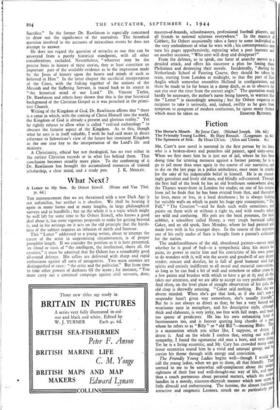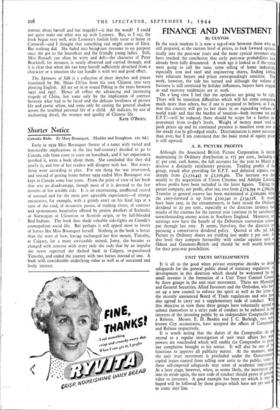Fiction
MR. CARY'S new novel is narrated in the first person by its hero, who is a broken-dovsin and penniless old painter, aged sixty-seven. When we first meet him he is just out of jail, where he has been doing time for uttering menaces against a former patron; he is to go to jail more than once again in the'course of our narrative, and to die on the last page in. a police ambulance, once more in trouble for the sake of his indomitable belief in himself. He is an exceed. ingly garrulouS and lively old man, and blindly self-centred. Through the first half of the book he has an old boathouse somewhere along the Thames water-front in London for studio; on one of his returns from jail he finds that he has been evicted from that, and thereaftei he lives, more or less, in a local dosshouse ; he is always looking for suitable walls on which to paint his huge epic conceptions, "'The Fall," " The Creation "—and he finds such walls sometimes, and paints on them with or without a right to, and with results which are wild and confusing. His pals are the local postman, the local cobbler, a schoolboy called Nosey, a very tough barmaid called Coker, and an old spark, Sara Monday, whom he had painted and made love with in his younger days. In the course of the narrative one of his early nudes of Sara is bought from a patron's collection for the nation.
The undefeatableness of the old, abandoned painter—never mind whether he is good of bad—is a sympathetic. idea; his mania for paint, its power to excite him and his conviction of his own power to do wonders with it, will win the assent and goodwill of any decent reader; outcast and derelict, he is full of good humour and high spirits and entirely indifferent to all moral and material conventions, so long as he can find a bit of wall and somehow or other come by a few paints and brushes with which to have a go at it; and all this takes our attention, and we are able to accept its very probable truth. And often, on the level plane of straight observation of his pals, the old chap is shrewdly amusing. "Coker said nothing. But she was absent minded. When she's got that look, as if she isn't sure suspender hasn't given way somewhere, she's usually friendly. But he is not always as direct as that; he has a very forced and wearisome taste in metaphors, and his descriptive style, although thick and elaborate, is very jerky, too free with full stops, and much too sparse of predicates. He has his own exhausting kind el facetiousness too, and is forever quoting long chunks of a poet whom he refers to as " Billy " or " old Bill "—meaning Blake. 111i; is a mannerism which you either like, I suppose, or detest. detest it. And on the whole I confess that, setting out with au sympathy, I found the egomaniac old man a bore, and very riling.
Yet he is a living eccentric, and Mr. Cary has crowded many oth!e lesser eccentrics round him In a vivid and unusual groups and he carries his theme through with energy and conviction. •
The Friendly Young Ladies begins well—though I would ad call the young ladies, when we got to them, all that friendly. Th
seemed to me to he somewhat self-complacent about the wig" rightness of their free and well-thought-out way of life, and IT!
than a touch portentous about personal matters, which the autnul handles in a moody, nineteen-thirtyish manner which now seen's, little demode and embarrassing. The heroine, the almost faultless'. attractive and enigthatic Leonora. struck me as particularly 170t
tentous about herself and her tragedy?—is that the word? I could not quite make out what was up with Leonora. But, as I say, the book began very well, with Leonora's foolish little sister at home in Cornwall—and I thought that something real might come of Elsie. But nothing did. She faded into being just tiresome to no purpose once she got to the houseboat and the friendly young ladies. Still, Miss Renault can often be witty and deft—the character of Peter Bracknell, for instance, is neatly observed and carried through, and it is clear that when she can keep herself sufficiently detached from a character or a situation she can handle it with wit and good effect.
The Spinners of Silk is a collection of short sketches and pieces translated by Mr. Hsiao Ch'ien from his own Chinese into very pleasing English. All are set in or round Peking in the years between 1932 and 1937. Hence all reflect the advancing and increasing tragedy of China, but some only by the implication of contrast between what had to be faced and the delicate loveliness of private life and poetic whim, and some only by casting the general shadow across the troubled personal life of a child. All indicate, by use of enchanting detail, the essence and quality of Chinese life.
KATE O'BRIEN.



























 Previous page
Previous page